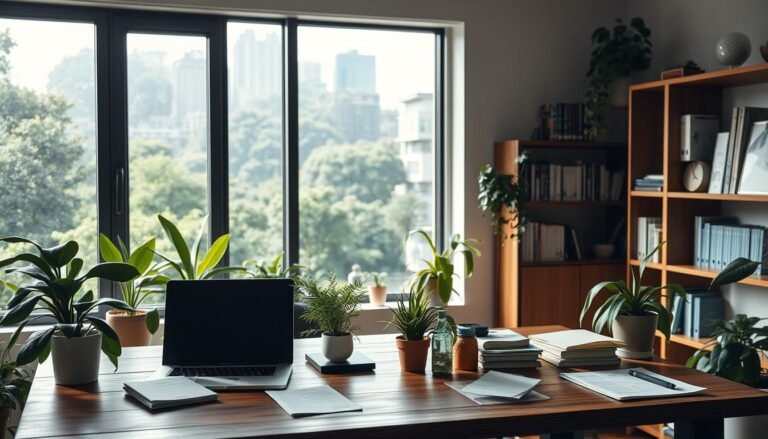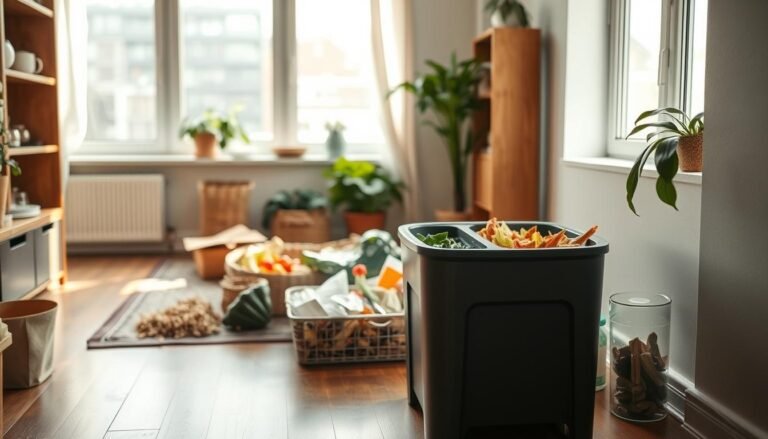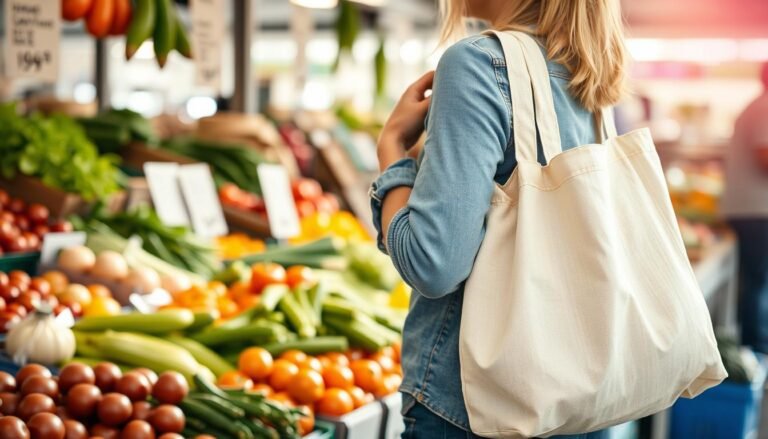As a small business owner in Australia, you’re constantly looking for ways to stand out while being mindful of your budget and the environment. One effective way to enhance your brand identity and attract eco-conscious customers is by adopting eco-friendly packaging practices.
By choosing sustainable packaging options, you can differentiate your business from competitors and appeal to the growing number of consumers who prioritise environmental responsibility. This not only benefits the planet but also boosts your brand’s reputation and customer loyalty.
Key Takeaways
- Enhance your brand identity with eco-friendly packaging.
- Attract eco-conscious customers and boost loyalty.
- Differentiate your business from competitors.
- Contribute to environmental responsibility.
- Improve your brand’s reputation.
The Environmental Packaging Landscape in Australia
As concern for the environment continues to grow, Australian businesses are reevaluating their packaging strategies to reduce their ecological footprint. The need for sustainable packaging solutions has become increasingly pressing, driven by both consumer demand and the imperative to mitigate environmental harm.
Current Waste Challenges Facing Australian Businesses
Australian businesses are grappling with significant waste challenges, particularly in the realm of packaging. The country’s packaging waste problem is substantial, with a considerable portion ending up in landfills or as litter.
This not only harms the environment but also represents a loss of resources. Businesses are under increasing pressure to adopt more sustainable packaging practices to reduce their environmental impact.
The Shift in Consumer Expectations for Eco-Friendly Products
Consumers today are increasingly eco-conscious, with many actively choosing products based on their environmental impact. A recent study revealed that 92% of consumers have a more positive image of a company when it supports an environmental cause.
This shift in consumer expectations is driving businesses to adopt eco-friendly packaging solutions, not just to reduce their environmental footprint but also to enhance their brand reputation and appeal to environmentally aware customers.
Sustainable Packaging for Small Businesses: Core Principles
Embracing sustainable packaging is a strategic move for small businesses, enhancing their brand reputation and contributing to a greener future. As consumers increasingly demand eco-friendly products, businesses must adapt to meet these expectations while maintaining functionality and reducing environmental impact.
Defining True Sustainability in Packaging
True sustainability in packaging refers to designs and materials that minimize environmental harm throughout their lifecycle. This involves using renewable resources, reducing waste, and ensuring that packaging is either recyclable, reusable, or compostable. Eco-friendly packaging not only reduces a business’s carbon footprint but also appeals to environmentally conscious consumers.
Circular Economy Approach for Small Business Packaging
Adopting a circular economy approach means designing packaging that is restorative and regenerative by design. This involves creating a closed-loop system where materials are continually cycled back into production, reducing the need for new raw materials and minimizing waste. Small businesses can achieve this by selecting materials that are recyclable or biodegradable and designing packaging that can be easily returned and reused.
| Packaging Material | Environmental Impact | Circular Economy Potential |
|---|---|---|
| Biodegradable Plastics | Lower carbon footprint, but potential for litter | Compostable, reducing waste |
| Recycled Paper | Low environmental impact | Recyclable, reusable |
| Compostable Materials | Reduces landfill waste | Compostable, turning waste into resource |
Balancing Functionality with Environmental Impact
While sustainability is crucial, packaging must also protect products during shipping and storage. Balancing these needs involves selecting materials that are both eco-friendly and functional. For instance, using biodegradable packaging peanuts or recycled paper fill can protect items while reducing environmental harm. Businesses should also consider minimalist designs that reduce material usage without compromising product safety.
Business Benefits of Embracing Eco-Friendly Packaging
Embracing eco-friendly packaging solutions can have a positive impact on both the environment and your business’s bottom line. By incorporating sustainable packaging into your business, you not only reduce your ecological footprint but also attract customers who value sustainability.
Environmental Impact Reduction and Carbon Footprint
One of the significant eco-friendly packaging benefits is the reduction in environmental impact. Sustainable packaging minimizes waste and lowers carbon emissions, contributing to a cleaner environment. For instance, using biodegradable materials can reduce landfill waste by up to 70%.
Enhanced Brand Reputation and Market Positioning
Adopting eco-friendly packaging can significantly enhance your brand reputation. Consumers are increasingly preferring businesses that prioritize sustainability. By showcasing your commitment to the environment, you can differentiate your brand in a crowded market and attract eco-conscious customers.
Customer Loyalty and Competitive Advantage
Eco-friendly packaging can also foster customer loyalty. When customers perceive your brand as environmentally responsible, they’re more likely to return and recommend your business to others. This loyalty can translate into a competitive advantage, setting your business apart from competitors.
| Benefits | Description | Impact |
|---|---|---|
| Environmental Impact Reduction | Minimizes waste and lowers carbon emissions | Contributes to a cleaner environment |
| Enhanced Brand Reputation | Showcases commitment to sustainability | Attracts eco-conscious customers |
| Customer Loyalty | Fosters loyalty among environmentally aware customers | Provides a competitive advantage |

By embracing eco-friendly packaging, businesses can reap multiple benefits while contributing to a more sustainable future.
Sustainable Packaging Materials Available in Australia
Australia’s shift towards sustainable packaging is driving demand for eco-friendly materials. As businesses increasingly prioritize environmental responsibility, the market is responding with a variety of innovative and sustainable packaging solutions.
Biodegradable Options for Australian Conditions
Biodegradable packaging materials are gaining traction in Australia. Made from plant-based sources such as corn starch, sugarcane, or potato starch, these materials offer a viable alternative to traditional plastics. Companies like Hero Packaging are at the forefront, offering compostable mailers that break down under specific conditions, reducing environmental impact.
Compostable Alternatives That Meet Australian Standards
Compostable packaging alternatives are designed to decompose into nutrient-rich compost. These materials must meet stringent Australian Standards, ensuring they are safe for the environment. Compostable packaging is particularly beneficial for food businesses, providing a sustainable solution for packaging that comes into contact with food.
Recycled and Recyclable Materials in the Australian Market
The use of recycled and recyclable materials is a cornerstone of sustainable packaging. In Australia, businesses are leveraging recycled paper, cardboard, and certain plastics to reduce waste. Recyclable materials are designed to be processed through existing recycling facilities, minimizing the environmental footprint of packaging.
Innovative Materials from Australian Suppliers
Australian suppliers are innovating with new materials that push the boundaries of sustainable packaging. From seaweed-based packaging to bioplastics made from agricultural waste, these innovations are set to revolutionize the industry. Businesses are encouraged to explore these cutting-edge materials to stay ahead of the sustainability curve.
Cost Considerations: Making Eco Packaging Financially Viable
For Australian small businesses, the decision to switch to eco packaging involves weighing the initial costs against the long-term benefits. While sustainable packaging may require a higher upfront investment, it can lead to cost savings and increased customer loyalty over time.
Initial Investment vs. Long-term Returns
The initial cost of eco-friendly packaging materials can be higher than traditional options. However, businesses can benefit from long-term returns through reduced waste, improved brand reputation, and potential increases in customer loyalty.
Volume Considerations for Small Businesses
Small businesses often face challenges with minimum order quantities for eco packaging. Some suppliers offer flexible ordering options, allowing businesses to purchase smaller quantities, making it more feasible to adopt sustainable packaging without a significant upfront cost.
Government Incentives and Support Programs in Australia
The Australian government offers various incentives for businesses adopting green practices. Programs such as the Entrepreneur’s Programme and Green Business Solutions provide funding and support for businesses looking to reduce their environmental impact.
| Incentive Program | Description | Benefit |
|---|---|---|
| Entrepreneur’s Programme | Funding for businesses to adopt innovative practices | Financial support for eco packaging adoption |
| Green Business Solutions | Support for businesses to reduce environmental impact | Expert advice and potential funding |
By understanding the cost considerations and leveraging government incentives, small businesses in Australia can make eco packaging a financially viable option, contributing to a more sustainable future.
Designing Eco-Friendly Packaging with Brand Impact
The intersection of eco-friendly materials and innovative design is where brands can truly make a statement with their packaging. As consumers become more environmentally conscious, the way a product is packaged can significantly influence purchasing decisions.
Minimalist Design Principles That Reduce Waste
Minimalist design is about simplicity and functionality. By using fewer materials and reducing unnecessary elements, brands can create packaging that is both eco-friendly and visually appealing. This approach not only reduces waste but also enhances the brand’s image by conveying a sense of elegance and sophistication.
Communicating Your Sustainability Story Through Packaging
Packaging is a powerful medium for telling a brand’s sustainability story. By incorporating elements that highlight eco-friendly practices, such as recyclable materials or biodegradable packaging, brands can communicate their commitment to sustainability directly to consumers. This transparency can foster trust and loyalty among customers who value environmental responsibility.
Creating Instagram-Worthy Unboxing Experiences Sustainably
The unboxing experience has become a crucial aspect of brand engagement, especially on social media platforms like Instagram. By designing packaging that is not only sustainable but also visually appealing, brands can create shareable moments that promote their products and values. This can be achieved through creative use of materials, color schemes, and design elements that reflect the brand’s identity while maintaining an eco-friendly ethos.
| Design Element | Eco-Friendly Approach | Brand Benefit |
|---|---|---|
| Minimalist Design | Reduces material usage | Enhances brand image |
| Sustainability Messaging | Communicates eco-friendly practices | Fosters customer trust and loyalty |
| Instagram-Worthy Unboxing | Uses sustainable materials creatively | Promotes brand engagement on social media |
Plastic-Free Shipping Solutions for Australian E-commerce
With the growing awareness of plastic waste, Australian e-commerce companies are turning to sustainable shipping alternatives. This shift is driven by consumer demand for eco-friendly practices and the need to reduce environmental impact.
Alternatives to Plastic Mailers and Bubble Wrap
One of the primary steps in adopting plastic-free shipping is to replace traditional plastic mailers and bubble wrap. Compostable mailers made from plant-based materials are a viable alternative, as they decompose naturally and reduce landfill waste.
Paper-Based Protective Packaging
Paper-based protective packaging is another effective solution. It is biodegradable, recyclable, and can be customized to fit various product sizes. This option not only protects products during shipping but also aligns with the eco-friendly branding of businesses.
Plant-Based Cushioning Materials
Plant-based cushioning materials, such as mushroom packaging or seaweed-based wraps, offer innovative protection for fragile items. These materials are not only sustainable but also provide excellent shock absorption.
Sustainable Void Fill Options for Fragile Items
For fragile items, sustainable void fill options are crucial. Recycled paper pulp and bioplastics made from renewable resources are effective alternatives to traditional plastic fillers. These materials minimize waste and reduce the carbon footprint of shipping.
| Material | Biodegradable | Recyclable |
|---|---|---|
| Paper Pulp | Yes | Yes |
| Bioplastics | Yes | No |
| Compostable Mailers | Yes | No |
Weather-Resistant Eco Packaging for Australian Conditions
Australian businesses must also consider weather-resistant eco packaging to protect products from the country’s varied climate conditions. Materials that are both waterproof and biodegradable are ideal, ensuring that products remain safe while minimizing environmental impact.
Australian Eco Packaging Suppliers Directory
As Australian businesses continue to prioritize environmental sustainability, the need for reliable eco packaging suppliers has never been more critical. The country is home to a diverse range of local manufacturers and distributors offering innovative, eco-friendly packaging solutions.
Local Manufacturers and Distributors by Region
Several Australian companies are leading the way in sustainable packaging. For instance, Hero Packaging and Eco Enclose are notable suppliers offering a variety of eco-friendly options, including compostable mailers and recycled materials. When searching for a supplier, it’s essential to consider their regional presence and ability to meet your specific business needs.
- New South Wales: Companies like EcoPack and Sustainable Packaging Solutions offer a range of eco-friendly packaging options.
- Victoria: Businesses can find sustainable packaging suppliers like Detmold Packaging and Packaging Industries.
Comparing Cost, Quality and Environmental Credentials
When selecting an eco packaging supplier, it’s crucial to compare their cost, quality, and environmental credentials. Look for suppliers that provide transparent information about their materials, production processes, and environmental impact.
- Evaluate the supplier’s environmental credentials, such as certifications or compliance with Australian sustainability standards.
- Compare the quality of their packaging materials, ensuring they meet your business requirements.
- Assess the cost-effectiveness of their solutions, considering both the initial investment and long-term savings.
By carefully evaluating these factors, Australian businesses can find the right eco packaging supplier to support their sustainability goals and enhance their brand reputation.
Implementing Green Business Solutions: A Practical Roadmap
The journey to a more sustainable business model involves several key steps, beginning with an assessment of current practices. For Australian small businesses, adopting eco-friendly packaging is not just about reducing environmental impact; it’s also about enhancing brand reputation and complying with evolving consumer expectations.

Auditing Your Current Packaging Practices
Begin by conducting a thorough audit of your current packaging materials and practices. Identify areas where waste can be reduced, and assess the environmental impact of your current packaging. This step is crucial in understanding where your business stands in terms of sustainability and what changes are needed.
Setting Achievable Sustainability Targets
Setting clear, achievable sustainability targets is essential. These targets should be specific, measurable, and aligned with your business goals. For instance, you might aim to reduce packaging waste by a certain percentage within a specific timeframe or switch to entirely recyclable materials.
Phased Implementation Strategies for Small Budgets
Implementing green business solutions doesn’t have to be costly. Develop a phased strategy that allows you to make gradual changes to your packaging practices. Start with the most impactful changes and work your way down, considering cost-effective alternatives and supplier options.
Staff Training and Process Integration
Finally, ensure that your staff is trained on new packaging practices and that these practices are fully integrated into your business processes. This includes educating staff on the importance of sustainability, the specifics of the new packaging, and how to handle any new materials or procedures.
By following this practical roadmap, Australian small businesses can effectively implement green business solutions, enhancing their sustainability and appeal to eco-conscious consumers.
Leveraging Eco Branding to Grow Your Small Business
In today’s environmentally conscious world, Australian small businesses can significantly benefit from embracing eco branding. By effectively communicating their commitment to sustainability, businesses can attract eco-conscious consumers and differentiate themselves in a competitive market.
Communicating Your Sustainability Journey to Customers
Sharing your sustainability journey with customers can foster trust and loyalty. This can be achieved through transparent communication about your eco-friendly practices, sourcing, and packaging. For instance, businesses can share behind-the-scenes content on social media, highlighting their efforts to reduce waste and carbon footprint.
Digital Marketing Strategies for Eco-Conscious Brands
Digital marketing plays a crucial role in promoting eco-conscious brands. Strategies such as SEO optimization, social media campaigns, and influencer partnerships can help reach a wider audience. For example, creating content around your sustainable practices and sharing it on platforms like Instagram can engage customers and promote your brand.
Using Packaging as a Storytelling Medium
Packaging can be a powerful storytelling tool for eco-conscious brands. By incorporating elements that communicate your sustainability story, such as eco-friendly materials and minimalist design, businesses can create an impactful unboxing experience. This not only enhances brand perception but also encourages customer loyalty.
| Eco Branding Strategy | Benefits | Examples |
|---|---|---|
| Communicating Sustainability Journey | Fosters trust and loyalty | Behind-the-scenes content on social media |
| Digital Marketing | Increases brand visibility | SEO optimization, social media campaigns |
| Packaging as Storytelling | Enhances brand perception | Eco-friendly materials, minimalist design |
Australian Regulations and Certifications for Packaging
Understanding Australian regulations and certifications for packaging is crucial for businesses aiming to enhance their sustainability credentials. As the country moves towards reducing packaging waste, compliance with existing regulations and adapting to future changes is essential.
The Australian Packaging Covenant Organisation (APCO) Requirements
The Australian Packaging Covenant Organisation (APCO) plays a pivotal role in promoting sustainable packaging. Businesses must adhere to APCO’s guidelines, which include designing packaging that is recyclable, reusable, or compostable. APCO also encourages companies to report their packaging data annually, fostering transparency and accountability.
Navigating Eco-Labels and Certifications in Australia
Eco-labels and certifications are vital for communicating a product’s environmental credentials. In Australia, certifications such as compostable and recyclable are governed by specific standards. Businesses should ensure that their packaging complies with these standards to avoid misleading consumers and to reap the benefits of genuine eco-labeling.
Preparing for Future Regulatory Changes
The Australian government is continually updating regulations to address environmental concerns. Businesses should stay informed about upcoming changes, such as the phasing out of certain materials or the introduction of new recycling technologies. By staying ahead of these changes, companies can maintain compliance and continue to innovate in sustainable packaging.
To remain competitive and compliant, Australian businesses must be proactive in understanding and adhering to packaging regulations and certifications. By doing so, they not only contribute to a more sustainable environment but also enhance their brand reputation among eco-conscious consumers.
Success Stories: Australian Small Businesses Leading in Eco Packaging
Leading the way in eco packaging, Australian small businesses are setting new standards. Companies across various sectors are embracing sustainable packaging solutions, reducing their environmental footprint while enhancing their brand reputation.
Retail and Product-Based Business Examples
Retailers like Zero Waste Cartel are revolutionizing the industry with compostable packaging. Their commitment to eliminating single-use plastics has not only reduced waste but also attracted eco-conscious consumers.
Another example is Who Gives A Crap, a company that has successfully marketed bamboo toilet paper with minimal, biodegradable packaging. Their approach has resonated with consumers looking for sustainable alternatives.
Food and Beverage Industry Innovations
The food and beverage sector is also witnessing significant innovations. Bean There Coffee Company, for instance, has switched to compostable coffee bags, reducing their waste output and appealing to environmentally aware customers.
“We’ve seen a significant increase in customer loyalty since switching to eco-friendly packaging. It’s not just about reducing waste; it’s about building a brand that our customers can trust and feel good about.”
Service-Based Businesses with Sustainable Packaging Solutions
Service-based businesses are also adopting sustainable packaging practices. For example, businesses offering subscription services are now using recyclable materials for their packaging, minimizing environmental impact.
| Business | Industry | Sustainable Packaging Solution |
|---|---|---|
| Zero Waste Cartel | Retail | Compostable Packaging |
| Bean There Coffee Company | Food & Beverage | Compostable Coffee Bags |
| Who Gives A Crap | Retail | Biodegradable Packaging |
These Australian small businesses are not only reducing their environmental impact but also setting examples for others to follow. Their commitment to sustainable packaging solutions is paving the way for a more eco-friendly future.
Overcoming Common Challenges in Eco Packaging Transition
As businesses move towards more sustainable practices, they encounter various eco packaging challenges. Transitioning to eco-friendly packaging requires careful consideration of several factors to ensure a smooth shift.
Addressing Product Protection and Durability Concerns
One of the primary concerns when switching to eco-friendly packaging is maintaining product protection and durability. Businesses can address this by selecting materials that are not only sustainable but also provide adequate protection for their products. For instance, using corrugated bubble wrap made from recycled materials can protect fragile items during shipping while reducing environmental impact.
Managing Customer Expectations and Education
Customers may have varying expectations regarding eco-friendly packaging. To manage these expectations, businesses should educate their customers about the benefits and potential differences in packaging. This can be achieved through clear communication on the packaging itself or through marketing campaigns that highlight the company’s commitment to sustainability.
Handling Seasonal Demands and Special Requirements
Seasonal fluctuations and special requirements can pose additional challenges for businesses transitioning to eco-friendly packaging. To overcome this, companies can adopt flexible packaging solutions that can be easily adapted to different products or seasonal demands. For example, using modular packaging designs that can be adjusted for various product sizes can help manage seasonal variations while maintaining sustainability.
Future Trends in Sustainable Packaging for Australian Businesses
The future of sustainable packaging in Australia is being shaped by innovative materials, changing consumer behaviours, and regulatory shifts. As the industry continues to evolve, businesses must stay ahead of the curve to remain competitive.
Emerging Materials and Technologies
New materials and technologies are revolutionizing sustainable packaging. Biodegradable plastics, mushroom-based packaging, and plant-based composites are just a few examples of emerging materials being developed to support eco-friendly packaging solutions. Innovative companies are investing in research and development to create packaging that is both functional and sustainable.
The Impact of Changing Consumer Behaviours
Consumer behaviours are shifting towards more eco-conscious choices, driving demand for sustainable packaging. Australian consumers are increasingly expecting businesses to prioritize environmental sustainability, influencing purchasing decisions and brand loyalty. Businesses that adapt to these changing behaviours will be better positioned to attract and retain customers.
Preparing Your Business for the Plastic-Free Future
As Australia moves towards a plastic-free future, businesses must prepare by adopting sustainable packaging practices. This involves assessing current packaging, exploring alternative materials, and implementing changes that align with consumer expectations and regulatory requirements. By taking proactive steps, businesses can stay ahead of the curve and capitalize on the growing demand for eco-friendly products.
Conclusion: Your Sustainable Packaging Journey Starts Now
Embarking on a sustainable packaging journey is a crucial step for small businesses in Australia to reduce their environmental footprint, enhance their brand reputation, and attract eco-conscious customers. By adopting eco-friendly packaging practices, businesses can make a significant impact on the environment while improving their market positioning.
The journey begins with understanding the core principles of sustainable packaging, selecting the right materials, and designing packaging that tells a sustainability story. Australian businesses can leverage local suppliers, government incentives, and digital marketing strategies to support their transition to eco-friendly packaging.
As consumer expectations continue to shift towards environmentally responsible products, businesses that embrace sustainable packaging will be better positioned to compete in the market. By starting your sustainable packaging journey now, you can stay ahead of the curve and contribute to a more environmentally conscious future.
Take the first step today by auditing your current packaging practices, setting achievable sustainability targets, and exploring innovative eco-friendly packaging solutions available in the Australian market.





